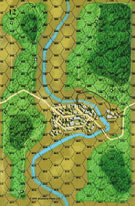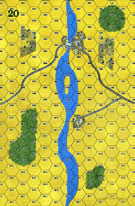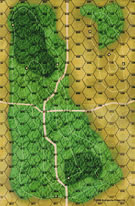| Author |
JayTownsend
|
| Method |
Solo |
| Victor |
Japan |
| Play Date |
2011-08-18 |
| Language |
English |
| Scenario |
NiSi004
|
*This scenario has actual Refinery & Airfield counters and the mostly Dutch with a few British units in support vs. the Japanese. This scenario also actually has a parachute drop. 5 out of the 10 scenarios have parachute or glider landings or mix of both. Besides step losses as victory point, the Airfields in the southwest and the refineries in the Northeast are where the main points are.
*At first I wasn’t sure about what AP did with my parachute drop & glider landing rules, as they seem more involved then I wanted but after using them, I really enjoyed that part of the game. There is more to keep track of the first couple of turns but is gives the Allied units with the weaker morale a better chance in 1942, as the Japanese have a very high morale in 1942 which falls off a bit in the 1944-45 scenarios.
*With the new drop rules, the Japanese really start off scattered around, some in demoralized or disrupted state and one lost a step and about half made the actual drop zone area. Some came on latter turns then planned, so it took me at least four turns to get everybody in some sort or organized fighting condition for the Japanese side, as few units were able to go forward right way. This was kind of a new fun twist in PG.
*The Allies had three forces, some Dutch at the airfield, some Dutch at the town of Palembang, required by setup and smaller detachment of the British Anti-aircraft, Infantry and some Dutch Engineers up in the refinery area. When the landing came, the Dutch sent their units in Palembang to reinforce their units at the airfield. The problem was, the Dutch at the airfield shouldn’t have waited around for reinforcement and just attacked the scattered, demoralized and disrupted Japanese paratrooper right away before they got organized. Once the Japanese got organized, time was on their side with the higher morale and took the airfield after about 15 turns, with most of the Dutch units in that area eliminated, demoralized or in the jungle south but still the Japanese had to leave units around the airfield, as there were just enough Dutch to take it back again if they left, so only a few could pull out and help their brothers still fighting in the north at the refineries.
*The refineries were kind of a different story, as the Japanese did really not have enough forces there and the British have a higher morale then the Dutch not to mention a big 40mm Anti-aircraft gun, that with some of their reduced infantry and some nasty Dutch Engineers made their lives difficult in the North. They lost over half their casualties there and one Japanese Lieutenant deserted and the other had a morale of only 7. How did I draw that counter? Being leaderless for a while, there wasn’t much for the Japanese to do but take pot-shots.
*Once the Japanese sent reinforcements to the north, the Dutch Engineers blow all the refineries up, denying the Japanese points and resources but also losing those victory points to themselves as well.
*The Japanese won a major victory, 24 points to 7 point a 17 point difference. Originally in my design the Allies would have received 3 points for each refinery destroyed and this would have changed the outcome to a minor Japanese victory but AP dropped this in the scenario but still allowed blowing them up for point denial.
*With such a higher morale, the Allies should have tried three different tactics to maybe change the outcome. One as I mentioned before, attack the Japanese right away, when they are scattered all over the place. Two, maybe blowup the refineries right away and sent those Northern units south to help defend the airfield or three, abandoned the airfield and defend the refineries. I am not sure the Allies can defend both areas unless they have luck in the beginning attacking disorganized Japanese units. Fun to play but with some of the changed victory conditions, I think it favors the Japanese a bit unless you use my counter strategies.
|





 NiSi003
NiSi003 


























